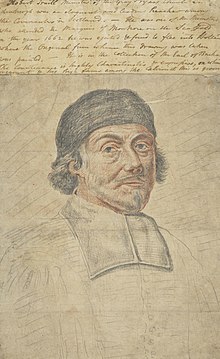Robert Traill | |
|---|---|
 | |
| Personal details | |
| Born | Robert Traill 1603 1678 |


Robert Traill of Greyfriars was born at Denino, in 1603.[2][3] He was son of Colonel James Traill, of Killcleary, Ireland, Gentleman of the Privy Chamber to Henry, Prince of Wales, and grandson of the Laird of Blebo, and Matilda Melvill of Carnbee.[4] He graduated with an M.A. from St Andrews on 21 July 1621. he went over to Paris, and subsequently joined his brother in Orleans.[2] He later studied at the Protestant College of Saumur. He was an English tutor in France to the sister of the Duke of Rohan in 1628.[5] He was afterwards teacher in a school established by a Protestant minister at Montague, in Bus Poitou.[2] He became chaplain to Archibald, Marquess of Argyll (beheaded 1661). In 1630 he returned to Scotland.[2]
He was ordained to Elie 17 July 1639. In 1640, he was ordered to attend Lord Lindsay's regiment at Newcastle for three months.[2] He was chaplain to the Scots army at Marston Moor in 1644. He was elected by the Town Council 7 November 1648. He became minister at Old Greyfriars on 23 March 1649.[6] In 1650 he attended the Marquess of Montrose on the scaffold. He was a protester rather than a resolutioner.[7] He preached before Charles II. at his coronation at Scone in 1651. In 1654 he was appointed by Cromwell one of those for certifying the ability and piety of such as were fit to be admitted to the ministry in the Lothian and Border provinces. With several others he was committed to Edinburgh Castle on 23 August 1660, for engaging in a new Remonstrance, where he lay for ten months, when, having fallen sick, he was temporarily permitted to return home. He was next charged with high treason before the Privy Council, when he obliged himself, 11 December 1662, to remove from the kingdom within a month, under pain of death. John Livingstone was tried the same day.[8]
- ^ Smith, John (1798). Iconographica Scotica. London: Robert Wilkinson. Retrieved 2 March 2019.
- ^ a b c d e f Anderson, William (1877). The Scottish nation; or, The surnames, families, literature, honours, and biographical history of the people of Scotland. Vol. 3. Edinburgh [etc.] : A. Fullarton & co. pp. 574-575. Retrieved 15 April 2019.
 This article incorporates text from this source, which is in the public domain.
This article incorporates text from this source, which is in the public domain.
- ^ Scott, Hew (1915). Fasti ecclesiae scoticanae; the succession of ministers in the Church of Scotland from the reformation (Vol 1). Edinburgh: Oliver and Boyd. Retrieved 27 February 2019.
 This article incorporates text from this source, which is in the public domain.
This article incorporates text from this source, which is in the public domain.
- ^ Traill, William (1883). A Genealogical Account of the Traills of Orkney, with a Pedigree Table ... Kirkwall, Orkney: J. Calder. pp. iii–v. Retrieved 3 March 2019.
- ^ Christie, James, ed. (1909). The records of the commissions of the general assembly of the Church of Scotland holden in Edinburgh in the years 1650-1652. Vol. 3. Edinburgh: Printed at the University Press by T. and A. Constable for the Scottish History Society. p. xix.
- ^ Bryce, William Moir; Fleming, D. Hay (1912). History of the Old Greyfriars' Church Edinburgh. Edinburgh: William Green and Sons. p. 94. Retrieved 2 March 2019.
- ^ Christie, James, ed. (1909). The records of the commissions of the general assembly of the Church of Scotland holden in Edinburgh in the years 1650-1652. Vol. 3. Edinburgh: Printed at the University Press by T. and A. Constable for the Scottish History Society. pp. 583.
- ^ Wodrow, Robert; Burns, Robert (1828–1830). The history of the sufferings of the church of Scotland from the restoration to the revolution, with an original memoir of the author, extracts from his correspondence, and preliminary dissertation. Vol. 1. Glasgow: Blackie, Fullarton & co., and Edinburgh: A. Fullarton & co. p. 287-332. Retrieved 7 April 2019.